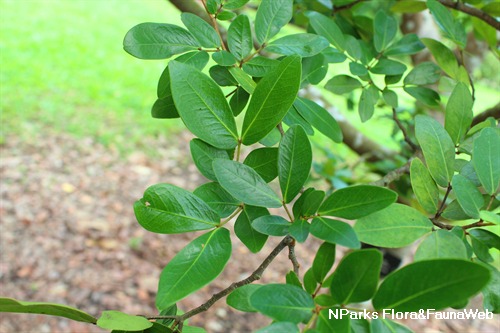
Back
Cynometra iripa Kostel.
| Family Name: | Fabaceae (Leguminosae) |
| Synonyms: | Cynometra ramiflora var. bijuga |
| Common Name: | Wrinkle Pod Mangrove, Kekatong Laut |
Name
Classifications and Characteristics
| Plant Division | Angiosperms (Flowering Seed Plants) (Dicotyledon) |
|---|---|
| Plant Growth Form | Tree (Small (6m-15m), Shrubby (1m-5m)) |
| Lifespan (in Singapore) | Perennial |
| Mode of Nutrition | Autotrophic |
Biogeography
| Native Distribution | Sri Lanka, India, Malaysia, Philippines, New Guinea and northeastern Australia |
|---|---|
| Native Habitat | Terrestrial (Coastal Forest), Shoreline (Mangrove Forest) |
| Preferred Climate Zone | Tropical |
Description and Ethnobotany
| Growth Form | A small sized tree up to 8 m tall. |
|---|---|
| Foliage | The compound leaves usually have two pairs of leaflets. Leaflet blades are oblong to elliptic, unequal sided, measuring 6-10 cm long and 2-5 cm wide. |
| Flowers | Flowers are white and small, borne in clusters. |
| Fruit | Fruits are compressed ellipsoid, measuring about 3 cm in diameter, wrinkled with a lateral beak. |
| Habitat | Back mangrove in coastal forests. |
| Cultivation | Genus Cynometra is from the Greek words. "kynos" means "a dog"; "metra" means "womb", and they refer to the shape of the fruit pod. |
Landscaping Features
| Desirable Plant Features | Ornamental Fruits, Ornamental Form |
|---|---|
| Landscape Uses | Coastal, Parks & Gardens, Shade Providing Tree / Palm |
Plant Care and Propagation
| Light Preference | Full Sun, Semi-Shade |
|---|---|
| Water Preference | Moderate Water |
| Plant Growth Rate | Moderate |
| Rootzone Tolerance | Moist Soils, Well-Drained Soils |
| Propagation Method | Seed |
Foliar
| Foliage Retention | Evergreen |
|---|---|
| Mature Foliage Colour(s) | Green |
| Foliar Type | Compound |
Floral (Angiosperm)
| Flower Colour(s) | White |
|---|---|
| Flower Grouping | Cluster / Inflorescence |
Fruit, Seed and Spore
| Mature Fruit Colour(s) | Brown |
|---|---|
| Mature Fruit Texture(s) | Wrinkled |
| Seed Quantity Per Fruit | Few (1-5) |
Image Repository
Others
| Master ID | 29698 |
|---|---|
| Species ID | 4007 |
| Flora Disclaimer | The information in this website has been compiled from reliable sources, such as reference works on medicinal plants. It is not a substitute for medical advice or treatment and NParks does not purport to provide any medical advice. Readers should always consult his/her physician before using or consuming a plant for medicinal purposes. |







